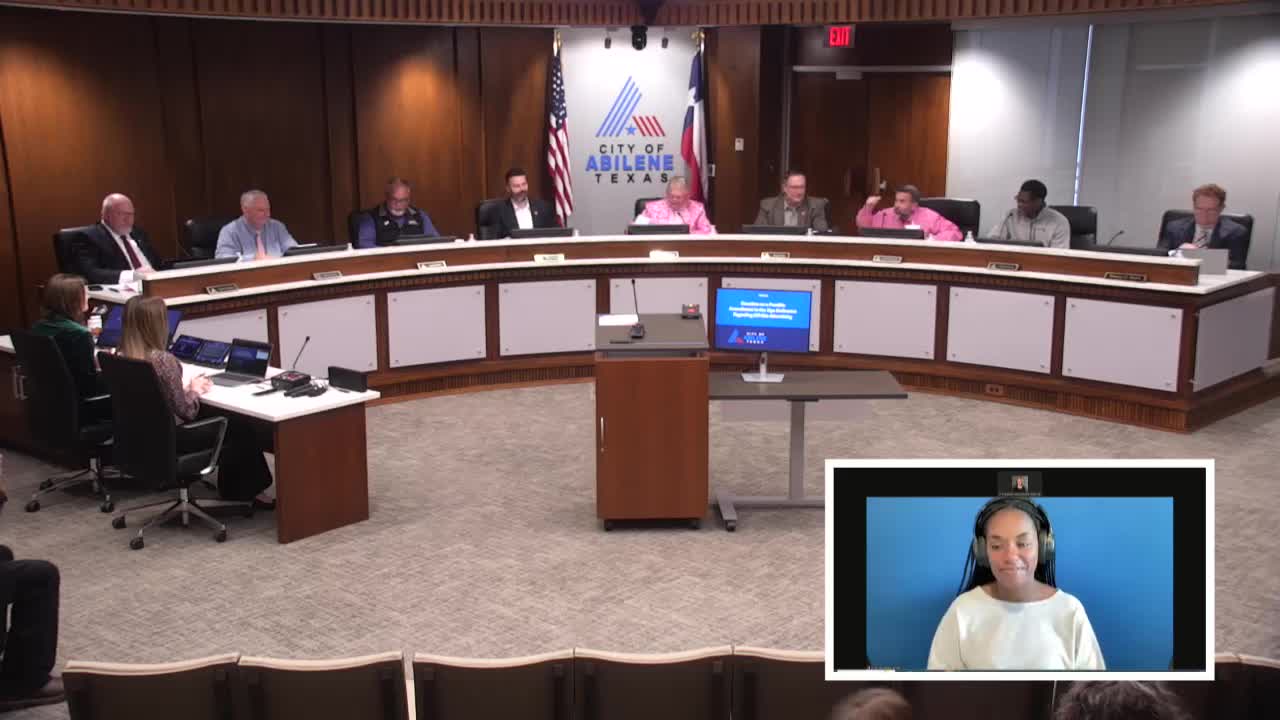City Council Debates Controversial Sign Ordinance Changes
October 17, 2024 | Abilene, Taylor County, Texas
This article was created by AI summarizing key points discussed. AI makes mistakes, so for full details and context, please refer to the video of the full meeting. Please report any errors so we can fix them. Report an error »

During a recent city council meeting, discussions centered on a proposed amendment to the sign ordinance, specifically regarding off-site advertising, including billboards and electronic message signs. Tim Littlejohn, the director of planning and development services, presented the potential changes aimed at allowing smaller off-site signage in new locations within the city limits.
Currently, off-site signage is restricted to specific zoning districts, including general retail and various industrial zones, with strict separation requirements from other signs and residential areas. The proposed amendment seeks to introduce a new category of signage, termed \"type 3 signs,\" which would permit smaller off-site advertising in designated areas, excluding the downtown region.
Littlejohn highlighted that while the new technology for smaller signs could enhance advertising opportunities, there are concerns regarding potential visual clutter and safety hazards associated with electronic signs. He noted that electronic signs would be subject to brightness and display regulations to mitigate distractions for drivers.
The council's discussion revealed a split opinion on the proposal. While some members expressed support for expanding advertising options to help revitalize areas like Butternut, others raised concerns about the aesthetic impact and the risk of the city resembling more commercialized areas, such as Las Vegas. A notable point of contention was the 2-to-1 vote against allowing such signs in the downtown area, driven by fears of uncontrolled advertising and sign pollution.
Public feedback during the meeting reflected similar apprehensions. Greg Ehlers, a representative from Lamar Outdoor Advertising, voiced opposition to the ordinance changes, arguing that they could lead to an oversaturation of signs that the public does not desire. Another resident, Tammy Fogel, shared her negative experience with a digital sign in the Soda district, describing it as overwhelming and disorienting.
The council is expected to deliberate further on the proposed amendments, weighing the potential economic benefits against community concerns regarding aesthetics and safety.
Currently, off-site signage is restricted to specific zoning districts, including general retail and various industrial zones, with strict separation requirements from other signs and residential areas. The proposed amendment seeks to introduce a new category of signage, termed \"type 3 signs,\" which would permit smaller off-site advertising in designated areas, excluding the downtown region.
Littlejohn highlighted that while the new technology for smaller signs could enhance advertising opportunities, there are concerns regarding potential visual clutter and safety hazards associated with electronic signs. He noted that electronic signs would be subject to brightness and display regulations to mitigate distractions for drivers.
The council's discussion revealed a split opinion on the proposal. While some members expressed support for expanding advertising options to help revitalize areas like Butternut, others raised concerns about the aesthetic impact and the risk of the city resembling more commercialized areas, such as Las Vegas. A notable point of contention was the 2-to-1 vote against allowing such signs in the downtown area, driven by fears of uncontrolled advertising and sign pollution.
Public feedback during the meeting reflected similar apprehensions. Greg Ehlers, a representative from Lamar Outdoor Advertising, voiced opposition to the ordinance changes, arguing that they could lead to an oversaturation of signs that the public does not desire. Another resident, Tammy Fogel, shared her negative experience with a digital sign in the Soda district, describing it as overwhelming and disorienting.
The council is expected to deliberate further on the proposed amendments, weighing the potential economic benefits against community concerns regarding aesthetics and safety.
View full meeting
This article is based on a recent meeting—watch the full video and explore the complete transcript for deeper insights into the discussion.
View full meeting
